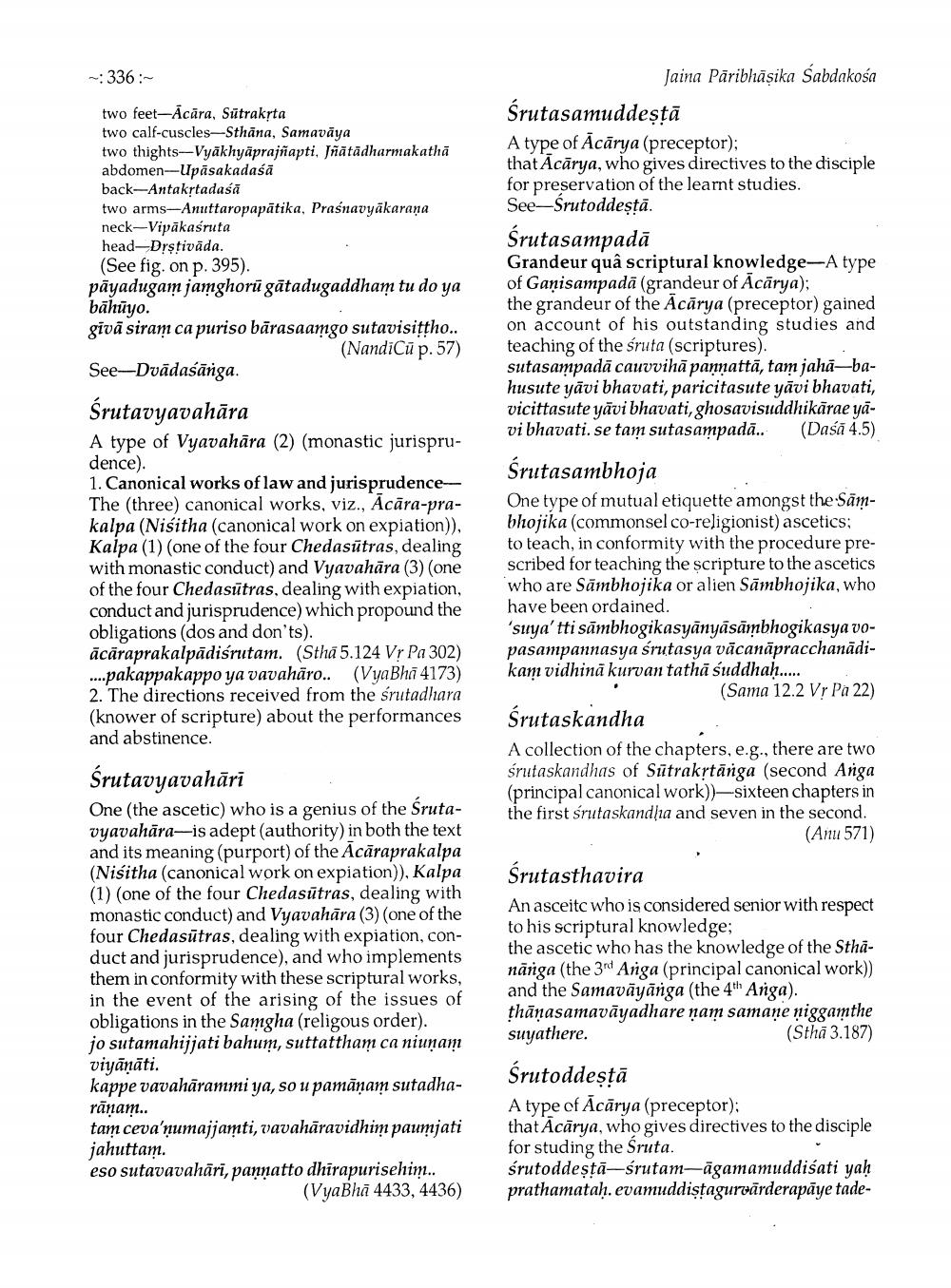________________
336:
two feet-Acāra, Sūtrakta two calf-cuscles-Sthāna, Samavāya two thights--Vyakhyaprajñapti, Jñätādharmakathā abdomen--upāsakadašā back-Antakytadasă two arms--Anuttaropapātika, Praśnavyäkarana neck-Vipākasruta head-Drstivāda. (See fig. on p. 395). pāyadugam jamghorūgātadugaddham tu do ya bāhūyo. givā siram ca puriso bārasaamgo sutavisittho..
(NandiCū p. 57) See-Dvādasānga.
Jaina Pāribhāșika Sabdakośa Śrutasamuddeştā A type of Ācārya (preceptor); that Acārya, who gives directives to the disciple for preservation of the learnt studies. See-Srutoddeștā. Śrutasampadā Grandeur quâ scriptural knowledge-A type of Gaņisampadā (grandeur of Acārya); the grandeur of the Acārya (preceptor) gained on account of his outstanding studies and teaching of the śruta (scriptures). sutasampadā cauvvihā pannattā, tam jaha-bahusute yāvi bhavati, paricitasute yāvi bhavati, vicittasute yāvi bhavati, ghosavisuddhikarae yāvi bhavati. se tam sutasampadā.. (Daśā 4.5)
Śrutavyavahāra A type of Vyavahāra (2) (monastic jurisprudence) 1. Canonical works of law and jurisprudenceThe (three) canonical works, viz., Ācāra-prakalpa (Nisitha (canonical work on expiation)), Kalpa (1) (one of the four Chedasūtras, dealing with monastic conduct) and Vyavahāra (3) (one of the four Chedasūtras, dealing with expiation, conduct and jurisprudence) which propound the obligations (dos and don'ts). ācāraprakalpädisrutam. (Stha 5.124 Vr Pa 302) ....pakappakappo ya vavahāro.. (VyaBha 4173) 2. The directions received from the srutadhara (knower of scripture) about the performances and abstinence.
Śrutasambhoja One type of mutual etiquette amongst the Sāmbhojika (commonsel co-religionist) ascetics; to teach, in conformity with the procedure prescribed for teaching the scripture to the ascetics who are Sāmbhojika or alien Sambhojika, who have been ordained. 'suya'tti sāmbhogikasyānyāsāmbhogikasya vopasampannasya śrutasya vācanäpracchanadikam vidhinä kurvan tathā suddhah.....
(Sama 12.2 Vr Pa 22) Śrutaskandha A collection of the chapters, e.g., there are two srutaskandhas of Sutrakrtānga (second Anga (principal canonical work))-sixteen chapters in the first srutaskandlia and seven in the second.
(Anu 571)
Śrutavyavahāri One (the ascetic) who is a genius of the Śrutavyavahāra—is adept (authority) in both the text and its meaning (purport) of the Acāraprakalpa (Niśitha (canonical work on expiation)), Kalpa (1) (one of the four Chedasūtras, dealing with monastic conduct) and Vyavahāra (3) (one of the four Chedasūtras, dealing with expiation, conduct and jurisprudence), and who implements them in conformity with these scriptural works, in the event of the arising of the issues of obligations in the Samgha (religous order). jo sutamahijjati bahum, suttattham ca niunam viyāṇāti. kappe vavahārammi ya, so u pamāṇam sutadharānam.. tam ceva'numajjamti, vavahāravidhim paumjati jahuttam. eso sutavavahāri, pannatto dhirapurisehim..
(VyaBhā 4433, 4436)
Srutasthavira An asceite who is considered senior with respect to his scriptural knowledge; the ascetic who has the knowledge of the Sthanārga (the 3rd Ariga (principal canonical work)) and the Samavāyārga (the 4"" Anga). thānasamavāyadhare nam samane niggamthe suyathere.
(Stha 3.187)
Srutoddestā A type of Ācārya (preceptor); that Acārya, who gives directives to the disciple for studing the Sruta. śrutoddeştā-srutam-agamamuddićati yah prathamataḥ. evamuddistagurvārderapāye tade




